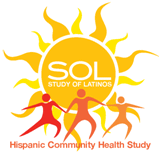| Title | Modeling longitudinal change in biomarkers using data from a complex survey sampling design: An application to the Hispanic Community Health Study/Study of Latinos. |
| Publication Type | Publication |
| Year | 2023 |
| Authors | Butera NM, Zeng D, Heiss G, Cai J |
| Journal | Stat Med |
| Volume | 42 |
| Issue | 5 |
| Pagination | 632-655 |
| Date Published | 2023 Feb 28 |
| ISSN | 1097-0258 |
| Keywords | Biomarkers, Cohort Studies, Hispanic or Latino, Humans, Public Health, Risk Factors |
| Abstract | In observational cohort studies, there is frequently interest in modeling longitudinal change in a biomarker (ie, physiological measure indicative of metabolic dysregulation or disease; eg, blood pressure) in the absence of treatment (ie, medication), and its association with modifiable risk factors expected to affect health (eg, body mass index). However, individuals may start treatment during the study period, and consequently biomarker values observed while on treatment may be different than those that would have been observed in the absence of treatment. If treated individuals are excluded from analysis, then effect estimates may be biased if treated individuals differ systematically from untreated individuals. We addressed this concern in the setting of the Hispanic Community Health Study/Study of Latinos (HCHS/SOL), an observational cohort study that employed a complex survey sampling design to enable inference to a finite target population. We considered biomarker values measured while on treatment to be missing data, and applied missing data methodology (inverse probability weighting (IPW) and doubly robust estimation) to this problem. The proposed methods leverage information collected between study visits on when individuals started treatment, by adapting IPW and doubly robust approaches to model the treatment mechanism using survival analysis methods. This methodology also incorporates sampling weights and uses a bootstrap approach to estimate standard errors accounting for the complex survey sampling design. We investigated variance estimation for these methods, conducted simulation studies to assess statistical performance in finite samples, and applied the methodology to model temporal change in blood pressure in HCHS/SOL. |
| DOI | 10.1002/sim.9635 |
| Alternate Journal | Stat Med |
| PubMed ID | 36631123 |
| PubMed Central ID | PMC10936944 |
| Grant List | HHSN268201300005C / HL / NHLBI NIH HHS / United States HHSN268201300004C / HL / NHLBI NIH HHS / United States HHSN268201300001C / HL / NHLBI NIH HHS / United States N01HC65236 / HL / NHLBI NIH HHS / United States N01HC65234 / HL / NHLBI NIH HHS / United States N01HC65233 / HL / NHLBI NIH HHS / United States N01HC65237 / HL / NHLBI NIH HHS / United States HHSN268201300003C / HL / NHLBI NIH HHS / United States P01 CA142538 / CA / NCI NIH HHS / United States 75N92019D00010 / HL / NHLBI NIH HHS / United States HHSN268201300003I / HL / NHLBI NIH HHS / United States N01HC65235 / HL / NHLBI NIH HHS / United States U01 DK098246 / DK / NIDDK NIH HHS / United States |
Modeling longitudinal change in biomarkers using data from a complex survey sampling design: An application to the Hispanic Community Health Study/Study of Latinos.
MS#:
0775
ECI:
Yes
Manuscript Affiliation:
Coordinating Center - Collaborative Studies Coordinating Center - UNC at Chapel Hill
Manuscript Status:
Published
